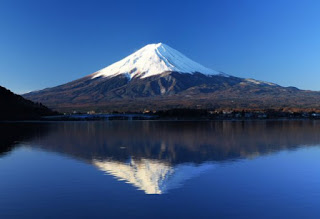Mount
Fuji (Fuji-san)
is the highest mountain in Japan, rising to 12,388 feet. It is
visible from Tokyo
on a clear day, the beautiful cone-shaped mountain is located west of
the city, surrounded by lakes in a national park. Mount
Fuji is
a frequent subject of Japanese
art especially
after 1600, when Edo
period has been born and (now
Tokyo) became the actual capital. Mt. Fuji is located in the
Fuji-Hakone-Izu National Park and is surrounded by five lakes: Lake
Kawaguchiko, Lake Yamanakako, Lake Saiko, Lake Motosuko and Lake
Shojiko. Fuji-san's dimensions are impressive: 12,388 feet high; 78
miles in circumference and 25-30 miles in diameter around the base;
topped with crater spanning 1600 feet in diameter. Mount Fuji is a
distinctive feature of the geography
of Japan.
It stands 3,776.24 m (12,389ft) high and is located near the Pacific
coast
of central Honshu,
just west of Tokyo. It straddles the boundary of Shizuoka
and
Yamanashi
prefectures.
Three small cities surround it:Gotemba
to
the east, Fujiyoshida
to
the north, and Fujinomiya
to
the southwest. It is also surrounded by five lakes: Lake
Kawaguchi,
Lake
Yamanaka,
Lake
Sai,
Lake
Motosu and
Lake
Shoji.
They,
and nearby Lake
Ashi,
provide views of the mountain. The mountain is part of the
Fuji-Hakone-Izu
National Park.
It can be seen more distantly from Yokohama, Tokyo, and sometimes as
far as Chiba,
Saitama,
Tochigiand
Lake
Hamana when
the sky is clear. Particularly in the winter it can be seen from the
Shinkansen until it reaches Utsunomiya station.
The mountain has been a subject of many
literary works, among is the most renowned of Hokusai's
36
Views of Mount Fuji and
One
Hundred Views of Mount Fuji,
as well as Utagawa
Hiroshige's
similarly titled 36
Views of Mount Fuji (1858).The
mountain is mentioned in Japanese literature throughout the ages.
It
is believed that the first recorded ascent was in 663 by an anonymous
monk. The summit has been thought of as sacred since ancient times
and was forbidden to women until the Meiji
Era.
Ancient samurai used the base of the mountain as a remote training
area, near the present day town of Gotemba.
Mt.
Fuji is named for the Buddhist fire goddess Fuchi and is sacred to
the Shinto goddess Sengen-Sama, whose shrine is found at the summit.
It is the holiest of Japan's "Three Holy Mountains." Every
summer, thousands of pilgrims and tourists climb to the summit, many
of them hiking throughout the night to witness the sunrise from the
summit.Mount Fuji is a volcano, which geologists estimate was created
600,000 years ago during the Pleistocene era. It last erupted in 1707
and is now dormant. According to Buddhist tradition, Fuji rose from
the earth in 286 BC after an earthquake that also created Lake Biwa
(the largest lake in Japan).
Fuji-san
has been regarded as sacred mountain for virtually as long as humans
have lived nearby. For Shintoists (modern followers of the native
religion), Mt. Fuji is sacred to the goddess Sengen-Sama and an
embodiment of the very spirit of nature. The Fujiko sect goes even
father, believing the mountain itself is a sacred being with a soul.
A
beautifully proportioned volcanic cone in a spectacular natural
setting, Fuji-san is beloved for its symmetrical beauty as well as
its holiness. It is a very popular subject in Japanese art and
landscape photography. Fuji's nickname Konohana-Sakuahime
means
"causing the blossom to bloom brightly," referring to the
pink cherry blossoms that frame the snowy mountain in the spring.
Unlike
some sacred mountains, it is not considered sacrilegious to climb Mt.
Fuji - in fact, to ascend to the summit is an important pilgrimage.
The mountain is home to many Shinto shrines, Buddhist temples and
torii gates. The mountain has to its official climbing season which
lasts only two months long (July and August), during which time most
of the snow has melted and thousands of pilgrims and hikers make the
climb to the top.
The
climb is no walk in the park - it is very steep and takes about 8
hours - but for many it is an experience of a lifetime. It is
estimated that up to a third of the climbers are foreign tourists,
making for an atmosphere that is at once quintessentially Japanese
and international. An especially memorable approach is to complete
the hike in the early morning, arriving at the summit in time to
witness the sunrise.
There
are ten stations along the way up, the first at the foot of the
mountain and the 10th at the summit. These include huts for resting
as well as other basic amenities. Paths are paved up to the 5th
station (at 1400-2400 m), which is the most common place to begin the
ascent to the summit. There are four 5th stations, located on
different sides of the mountain, among which the most popular is
Kawaguchiko on the Tokyo side.
- "Fujisan, sacred place and source of artistic inspiration: Maps". World Heritage. UNESCO. Retrieved 2013-07-04.
- Cortazzi, Hugh et al. Britain and Japan, 1859-1991, pp. 99-100.
- Triangulation station is 3775.63m. "Information inspection service of the Triangulation station" (in Japanese). Geospatial Information Authority of Japan, (甲府-富士山-富士山). Retrieved February 8, 2011.
- Yoshitomo, Takahashi (Summer 1988). "Aokigahara-jukai: Suicide and Amnesia in Mt. Fuji's Black Forest". Suicide and Life-Threatening Behavior. 18 (2): 164–75.PMID 3420643.
- "Fuji". Global Volcanism Program. Smithsonian Institution.



Komentarze
Prześlij komentarz